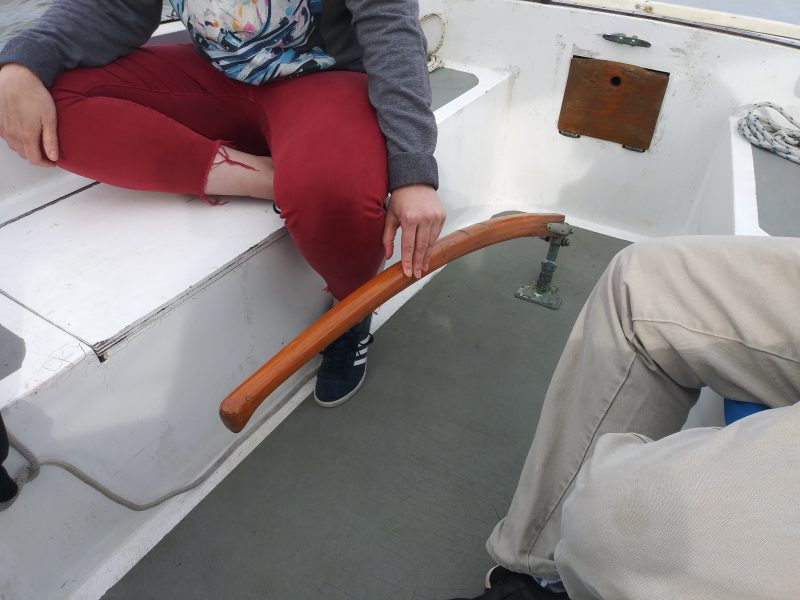
It’s the Question that Drives Us
The problem is not severe. It can barely be called a problem at all. But if you’re sitting down and helming on a long, slow run on my boat, you’ll find that you have to hunch over — almost imperceptibly — to< steer. You might even notice a little cramping creeping into your shoulders and back.
The tiller seems as if it’s just a little too low.

“So why not just, make a new tiller?” asked my friend, who is a carpenter, and was fully aware (I think) that he was volunteering for the job.
The ‘sunken-ness’ of the stick can be partially remedied by tightening up the hardware that attaches it to the rudder post. For over a year, I’ve been meaning to replace the bolts and nuts at the connection. At present, even after tightening everything with a wrench — which does put some stiffness in the tiller and helps it settle higher in the cockpit — there is an inevitable sag, and the stick eventually ends up slumping again.
But in addition to this easy and more gettable fix, I also feel like the tiller is just a hair too short, and could stand to have a little more rake in it so that it naturally curves to a higher resting position. It all sounds like a brilliant idea to me. What could possibly go wrong?

But seriously, Latitude Nation, what could go wrong? What are the disadvantages of modifying the tiller and making it larger than the original design (assuming this is, in fact, an original Columbia 24 tiller length)? I feel like tweaking the tiller is like messing with nature — not unlike those scientists who recreated dinosaurs by extracting DNA from amber.
What freakish Frankenstein might come forth? What are the unforeseen consequences?
Please either comment below or email us here, and please be sure to include your Boat Name, Make and Port of Call.

You just reminded me of a crucial rule – Try it Before You Buy! Want to change the level? Much easier to place a shim under the heel (where it meets the rudder post) and then sailing for a while (change the shim to change the level) A longer tiller van be temporarily achieved with a stick and duct tape. By trying, you may discover why the original design was built.
I built a lamented oak tiller and a flip up rudder for an El Toro, very satisfying indeed, but for you I recommend a high quality tiller extension first.
Some folks even go beach combing for a tiller with one of a kind characteristics…. get a few different options for backup tiller. My guess is that you will replace the bolt and enjoy the tiller as is!
Tiller extender, folks. It’s an amazing add-on!
Get a tiller extension or ‘hiking stick’. This means you can sit up on the rail where you can see and put your weight to weather. I don’t know a racing sailboat with a tiller without one.
I’m thinking the reason your tiller won’t lift is too much wood at the butt end is interfering with the rudder post. Shave off a quarter inch or so — the tiller should then be free to swing up to a comfortable position.
Steer with your foot or look into the cause of non-rise of tiller stick like Mr. Brogger explains. Then look into tiller extender. Just remember that with every degree of rise/arc of the tiller going up so does the stress factor on the tiller components of bolt and wood at connection point of rudder and load on your arm.
Does the tiller pivot vertically, lift up? If not, that is a feature that you might want to incorporate into your new design. But if it already does, I’d look for a way to temporarily lock it into a higher position in order to test the feel. Tiller extensions are great, but sometimes I want to be able to handle the tiller directly. Particularly under power coming into a dock, where I stand and pivot the tiller up to match my height. If you make it longer, be sure it will swing left to right as it did before without striking something. And understand that it will take more arm movement for the same rudder movement. But you can always “choke up” on a longer tiller to deal with that.